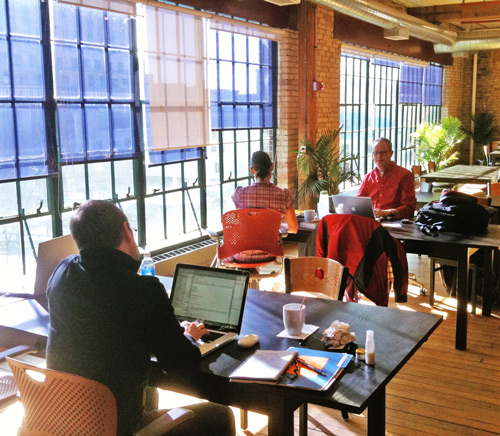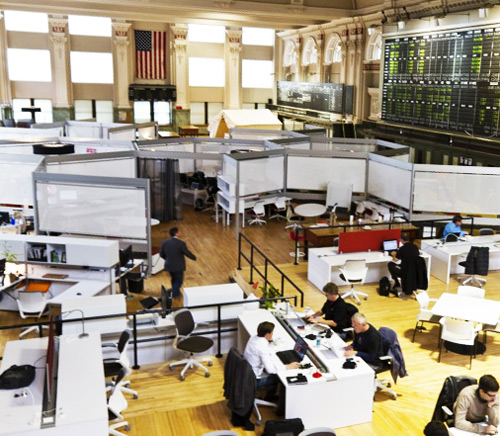Cowork Centers Continue to Grow and Evolve

Who will you meet?
Cities are innovating, companies are pivoting, and start-ups are growing. Like you, every urban practitioner has a remarkable story of insight and challenge from the past year.
Meet these peers and discuss the future of cities in the new Meeting of the Minds Executive Cohort Program. Replace boring virtual summits with facilitated, online, small-group discussions where you can make real connections with extraordinary, like-minded people.
The metropolitan area of Hartford Connecticut has seen two coworking centers open in the past several months. Axis 901 is upstairs from an art gallery on Main Street in Manchester Connecticut. It has attracted technology startups and writers among others to open space and private offices. ReSet recently opened in downtown Hartford as part of a social enterprise incubator and community coworking space.
To get a sense of some firsthand experience of working in a coworking center I reached out to Sean Kershaw, Executive Director of the Citizens League based in the Twin Cities in Minnesota. The Citizens League, which I headed for 11 years before Sean, moved to the CoCo center in Saint Paul 18 months ago. The center is in a former warehouse across the street from Union Station and an upcoming light rail stop in Saint Paul.
According to Sean Kershaw there were “no downsides” to moving from their own exclusive office space to a coworking center. The coworking center “has worked well and beyond what we expected.” For the Citizens League it was a less expensive and more flexible option—not more space than our organization would need. It was as he said “in a cool old warehouse.”
Initially they were hesitant about open space, but they find private space when they need it. In his view “we keep running into interesting people. One person is working on water quality by finding ways to micro apply fertilizers to minimize agricultural runoff.” There is a choice of two related coworking centers—one in Minneapolis and in Saint Paul. According to Sean, “it is great to have a choice of two centers and to be able to work in different places and for a change of scenery.” In his view, coworking has been “good on the margins for recruitment.”
Nationwide Growth
Growth in coworking centers seems to be picking up in many parts of the country. The movement seems to be in rapid evolution along several dimensions. One dimension of this evolution is general versus specialized centers. Some coworking centers accept all comers willing to pay for use of the facilities (CoCo in Minneapolis and Saint Paul, Minnesota, for example) while others are focused on writers (Brooklyn), fashion and design (San Diego) and business startups (Axis 901). It will be interesting to see whether specialization becomes the norm. Users have remarked on the benefits of cross fertilization and serendipity involved in mixing a variety of backgrounds and aims.
A second dimension is whether the cowork center is used for a day or two a week or a full time work space. Cowork centers offer a menu of time options from daily to intermittent use. Is the cowork center acting as a supplement to home work space or as a replacement? This may relate to limited residential space in some cities or the desires and needs of users. It will be interesting to see just how much of users’ work time in spent in cowork spaces rather than home offices or other sites.
A third dimension is solo use versus work team use of coworking spaces. Coworking centers can attract individuals working on projects or work teams. With use of videoconferencing and other remote conferencing tools work teams can be spread around the globe as well. It will be interesting to see how the mix of individuals, work teams and remote work teams evolves in centers over time.
How coworking centers evolve on these three dimensions over the next few years should be interesting to watch.
Discussion
Leave your comment below, or reply to others.
Please note that this comment section is for thoughtful, on-topic discussions. Admin approval is required for all comments. Your comment may be edited if it contains grammatical errors. Low effort, self-promotional, or impolite comments will be deleted.
Read more from MeetingoftheMinds.org
Spotlighting innovations in urban sustainability and connected technology
Middle-Mile Networks: The Middleman of Internet Connectivity
The development of public, open-access middle mile infrastructure can expand internet networks closer to unserved and underserved communities while offering equal opportunity for ISPs to link cost effectively to last mile infrastructure. This strategy would connect more Americans to high-speed internet while also driving down prices by increasing competition among local ISPs.
In addition to potentially helping narrow the digital divide, middle mile infrastructure would also provide backup options for networks if one connection pathway fails, and it would help support regional economic development by connecting businesses.
Wildfire Risk Reduction: Connecting the Dots
One of the most visceral manifestations of the combined problems of urbanization and climate change are the enormous wildfires that engulf areas of the American West. Fire behavior itself is now changing. Over 120 years of well-intentioned fire suppression have created huge reserves of fuel which, when combined with warmer temperatures and drought-dried landscapes, create unstoppable fires that spread with extreme speed, jump fire-breaks, level entire towns, take lives and destroy hundreds of thousands of acres, even in landscapes that are conditioned to employ fire as part of their reproductive cycle.
ARISE-US recently held a very successful symposium, “Wildfire Risk Reduction – Connecting the Dots” for wildfire stakeholders – insurers, US Forest Service, engineers, fire awareness NGOs and others – to discuss the issues and their possible solutions. This article sets out some of the major points to emerge.
Innovating Our Way Out of Crisis
Whether deep freezes in Texas, wildfires in California, hurricanes along the Gulf Coast, or any other calamity, our innovations today will build the reliable, resilient, equitable, and prosperous grid tomorrow. Innovation, in short, combines the dream of what’s possible with the pragmatism of what’s practical. That’s the big-idea, hard-reality approach that helped transform Texas into the world’s energy powerhouse — from oil and gas to zero-emissions wind, sun, and, soon, geothermal.
It’s time to make the production and consumption of energy faster, smarter, cleaner, more resilient, and more efficient. Business leaders, political leaders, the energy sector, and savvy citizens have the power to put investment and practices in place that support a robust energy innovation ecosystem. So, saddle up.








0 Comments